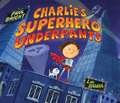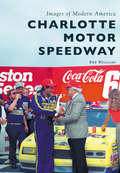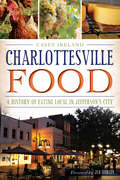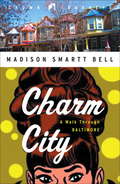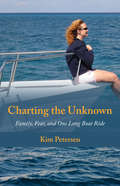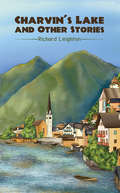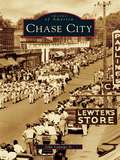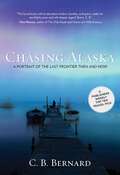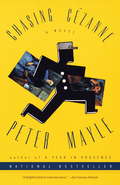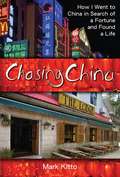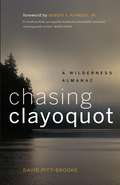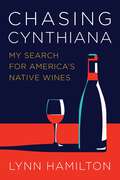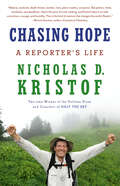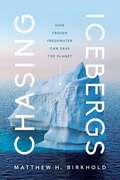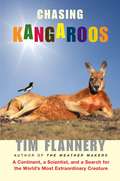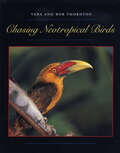- Table View
- List View
Charlie's Superhero Underpants
by Paul BrightOn a wild and windy day all the laundry blows away. Socks and shirts, a woolly hat, and--far worse than all of that--is Charlie's Superhero Underpants! Disaster! Charlie sets off around the world to find them. He discovers a fine French fox wearing Sophie's socks, and he finds a pair of llamas wearing brother Ben's pajamas . . . but WHO'S got Charlie's Superhero Underpants?
Charlotte Motor Speedway: From Granite To Gold (Images of Modern America)
by Deb WilliamsWhen Charlotte Motor Speedway opened in June 1960, the track built by Bruton Smith and Curtis Turner became a cornerstone in the decade that launched NASCAR’s superspeedway era. Stock car racing’s first paved 1.5-mile track immediately grabbed the motorsports world’s attention with the young sport’s longest event—a 600-mile race. And the track never left the spotlight, despite struggling through several years of bankruptcy. After regaining control of his beloved track in 1975, Smith, along with former speedway general manager H.A. “Humpy” Wheeler and current president Marcus Smith, transformed the facility into a groundbreaking showplace with trackside condominiums, a 16,000-square-foot high-definition television screen, the luxurious Speedway Club, VIP suites, stadium seating, and the first superspeedway in NASCAR’s modern era to host night racing. The historic speedway has always been a favorite with Hollywood filmmakers and in recent years has expanded into a multiuse motorsports facility.
Charlottesville
by Eryn S. Brennan Margaret MaliszewskiNestled in the foothills of the Blue Ridge Mountains, the city of Charlottesville thrives amidst numerous tangible reminders of an incredibly rich history. Founded in 1762, the heart of early Charlottesville was the stage for some of the most important figures in early American history, including Thomas Jefferson, James Madison, and James Monroe. Growing side by side with Jefferson's University of Virginia, Charlottesville developed into a bustling community whose businesses, families, and celebrations were well documented in photographs beginning in the 1880s. The collection of images reproduced in Images of America: Charlottesville tells the story of the creation, growth, hardship, transformation, and success of a city beloved by residents and visitors alike.
Charlottesville Dogwood Festival, The (Images of America)
by Elizabeth D. SmithDuring the month of April, the residents of Albemarle, Buckingham, Fluvanna, Greene, Louisa, Madison, Nelson, and Orange Counties converge on the city of Charlottesville to celebrate the beauty of Central Virginia and honor the state flower. Beginning in 1950 as the Apple Harvest Festival, the festival took on its current name, the Charlottesville Dogwood Festival, in 1958. Each year, Charlottesville comes alive not only with the blooms and blossoms of spring, but with fireworks, amusement rides, and a host of local royalty. The beauty of the Blue Ridge Mountains and fall foliage as well as breathtaking springs and some of the nation's oldest and most prestigious plantations make this area one of the most popular places to visit in the South. The Charlottesville Dogwood Festival takes pride in being a long-standing part of an area rich in tradition and heritage.
Charlottesville Food: A History of Eating Local in Jefferson's City (American Palate)
by Casey IrelandFrom the early days of Thomas Jefferson's "Garden Book" at Monticello to the hustle and bustle of the modern City Market on Water Street, Charlottesville has an illustrious culinary history. The city's cuisine is characterized by a delight in locally raised ingredients. The locavore mentality appears at all levels of Charlottesville's food industry, including the nationally acknowledged methods of Joel Salatin's Polyface Farms, the sourcing of local pork for Chipotle's Charlottesville location and the accessibility of regional ingredients everywhere from Whole Foods Market to online favorite Relay Foods. Author and food enthusiast Casey Ireland explores how Charlottesville's residents have created a food culture that is all their own..
Charm City
by Madison Smartt BellWith a writer’s keen eye, a longtime resident’s familiarity, and his own sly wit, acclaimed novelist Madison Smartt Bell leads us on a walk through his adopted hometown of Baltimore, a city where crab cakes, Edgar Allan Poe, hair extensions, and John Waters movies somehow coexist. From its founding before the Revolutionary War to its place in popular culture—thanks to seminal films like Barry Levinson’s Diner, the television show Homicide, and bestselling books by George Pelecanos and Laura Lippman—Baltimore is America, and in Charm City, Bell brings its story to vivid life. First revealing how Baltimore received some of its nicknames—including “Charm City”—Bell sets off from his neighborhood of Cedarcroft and finds his way across the city’s crossroads, joined periodically by a host of fellow Baltimoreans. Exploring Baltimore’s prominent role in history (it was here that Washington planned the battle of Yorktown and Francis Scott Key witnessed the “bombs bursting in air”), Bell takes us to such notable spots as the Inner Harbor and Federal Hill, as well as many of the undiscovered corners that give Baltimore its distinctive character. All the while, Charm City sheds deserved light onto a sometimes overlooked, occasionally eccentric, but always charming place. From the Hardcover edition.
Charting Scottish Tourism and the Early Scenic Film: Access, Identity and Landscape
by Samantha WilsonWhat impact did walking tours and scenic films have on leisure activities? In what ways did working class travel disrupt normative narratives concerning nature and identity? The appreciation of nature and leisure travel have a complex and interrelated history in Scotland. In Charting Scottish Tourism, Wilson looks at how scenic filmmaking altered the construction of the tourist map and spatial identities at the turn of the 20th Century. Scenic film, the author argues, played a key role in the expansion of regional travel and national tourism during the period. In addition, scenic film provides the modern researcher with an unrivalled source of documentary evidence relating to the manner in which Scottish working and middle class communities explored and reclaimed the natural spaces around them. The author examines the central role of the Scottish scenic within leisure performances and the way in which these films promoted and challenged normative spatial narratives. These discursive shifts, she argues, had a wide-reaching impact on popular assumptions concerning space, nature and identity both home and away. Charting Scottish Tourism provides a fascinating case study and numerous methodological insights for students and researchers interested in documentary film as well as the construction of identity and the natural world.
Charting the Unknown
by Kim PetersenThis is Kim Petersen's memoir recounting how she and her family navigated through death of a child, facing fear of the water, personally building a sixty-five-foot power catamaran and a four thousand mile crossing of the Atlantic Ocean with her husband and two teenaged kids. It's Eat, Pray, Love on the water.
Charvin's Lake and Other Stories
by Richard LeightonAndrew Falconer was born to be Head Gardener, but he was also born to travel and meet some unlikely people along the way, but then as the saying goes, 'you can never really escape your fate'. Charvin's Lake is based on a series of lively adventures as lived by Andrew Falconer, who, whilst working in England and the South of France, unwittingly finds himself caught up in all sorts of unforeseen adventures that include intense family drama, a murder mystery, dealing with unwanted ghosts, stumbling upon an old bronze inkwell that seems to possess strong supernatural powers and the restoration of an ancient park with more than a few surprises. In spite of all this, he still manages to fit in plenty of trout fishing and hiking in his spare time and does all this in the company of numerous companions who are instantly drawn to his adventurous lifestyle, as well as his natural talent for being both everywhere and everything, but certainly not for being boring.
Chase City (Images of America)
by John Caknipe Jr.The rich and vibrant history of Chase City, originally called Raine's Tavern, dates back to the mid-1700s. With its mineral springs and fertile farm and timberlands, Chase City, named for former Supreme Court justice Salmon P. Chase, has been a tourist destination since 1733 when surveyor William Byrd II dubbed the area the "Land of Eden." Depicted in this volume are the prosperous days of Thoroughbred racehorses and plantations in the 1850s to Reconstruction from 1866 to 1877. The rise, fall, and rebound of the town are traced through vintage photographs, as is the city's current status as the center for commerce and culture, and as a leader in Southside's tobacco market.
Chase: A chilling tale of psychological suspense
by Dean KoontzA race against time... and a deadly killer. Chase is an unputdownable thriller of pacey action, suspense and a terrifying killer, from bestselling author Dean Koontz. Perfect for fans of Richard Laymon and Harlan Coben.'A master storyteller his fast-paced plots are wonderfully fiendish, taking unexpected twists and turns' - San Diego Union-TribuneBen Chase is a war hero with bitter memories. Vietnam left him with a hard drinking habit, a mental breakdown - and massive guilt.So who will believe him when he swears a psychopath is out to get him? When society is sick, the mad are sane - and persecution is a killer's game... What readers are saying about Chase: 'Great vintage Koontz, tightly plotted, full of twists and well written''A good thrilling read that kept me turning the pages to find out what happened next''Five stars'
Chasing Alaska: A Portrait of the Last Frontier Then and Now
by C. B. BernardAlaska looms as a mythical, savage place, part nature preserve, part theme park, too vast to understand fully. Which is why C. B. Bernard lashed his canoe to his truck and traded the comforts of the Lower 48 for a remote island and a career as a reporter. He soon learned that a distant relation had made the same trek northwest a century earlier. Captain Joe Bernard spent decades in Alaska, amassing the largest single collection of Native artifacts ever gathered, giving his name to landmarks and even a now-extinct species of wolf. C. B. chased the legacy of this explorer and hunter up the family tree, tracking his correspondence, locating artifacts donated to museums, and finding his journals at the University of Alaska at Fairbanks. Using these journals as guides, he threw himself into the state once known as Seward&’s Folly, boating to remote islands, hiking distant forests, hunting and fishing the pristine environment, forming a landscape view of the place that had lured him and &“Uncle Joe,&” both men anchored beneath the Northern Lights in freezing, far-flung waters, separated only by time. Here, in crisp, crystalline prose, is his moving portrait of the Last Frontier, then and now.
Chasing Cezanne: A Novel
by Peter MayleHanky-panky on the international art scene is the source of the hilarity and fizz in Peter Mayle's new novel. He flies us back to the south of France (a region some readers of his irresistible best-sellers believe him to have invented), on a wild chase through galleries, homes of prominent collectors, and wickedly delectable restaurants. There are stopovers in the Bahamas and England, and in New York, where that glossiest of magazines, Decorating Quarterly, reflects the cutting-edge trendiness of its editor, Camilla Jameson Porter. (Camilla has recently broken new ground in the world of power lunches by booking two tables on the same day, and shuttling between them, at the city's trendiest restaurant.)It is Camilla who has sent our hero, Andre Kelly, to Cap Ferrat to take glamorous photo-graphs of the houses and treasures of the rich, famous, and fatuous. He happens to have his camera at the ready when he spots a Cézanne being loaded onto a plumber's truck near the home of an absent collector. Odd, thinks Andre. And in no time he's on the trail of a state-of-the-art art scam, chasing Cézanne.It's a joy to follow him and the crowds intent on speeding or foiling his quest--including a beautiful agent; a super-savvy art dealer attracted to the finer things in life, especially if they promise the payoff of a lifetime; an awesome Dutch forger; some outstandingly greedy New York sophisticates; and, invisible in the background, the parade of remarkable chefs whose mouthwatering culinary masterpieces periodically soothe the hero and tantalize the reader of Chasing Cézanne.
Chasing China: How I Went to China in Search of a Fortune and Found a Life
by Mark KittoAn astonishing, cautionary tale of how Westerner Mark Kitto built a successful media empire in China, creating and running 3 magazines, only to have the state take his business, and his livelihood, away. I had fought off attacks from jealous rivals and been investigated by every bureau with the slightest connection to publishing, and by many who did not: nine in total. I had paid over 1 million Yuan in fines, and who knows how much more in administration fees to government 'agencies. ' I had been accused of being a pimp, a China 'splittist,' a Falun Gong supporter, a pornographer and a spy. My staff had been extradited, my office computers confiscated, and my magazines impounded at the printers. I had got them all back. I had been through eight government publishing partners before China Intercontinental Press, and half a dozen advertising agencies. Mark Kitto on his experience as a business owner in China.
Chasing China: How I Went to China in Search of a Fortune and Found a Life
by Mark KittoAn astonishing, cautionary tale of how Westerner Mark Kitto built a successful media empire in China, creating and running 3 magazines, only to have the state take his business, and his livelihood, away. "I had fought off attacks from jealous rivals and been investigated by every bureau with the slightest connection to publishing, and by many who did not: nine in total. I had paid over 1 million Yuan in fines, and who knows how much more in administration fees to government 'agencies.' I had been accused of being a pimp, a China 'splittist,' a Falun Gong supporter, a pornographer and a spy. My staff had been extradited, my office computers confiscated, and my magazines impounded at the printers. I had got them all back. I had been through eight government publishing partners before China Intercontinental Press, and half a dozen advertising agencies.” -Mark Kitto on his experience as a business owner in China
Chasing Clayoquot
by Robert F. Kennedy Jr. David Pitt-BrookeFirst published in 2004, and now with a new introduction by the author and a foreword by Robert F. Kennedy Jr., this book of natural history, environmentalism, and politics explores one of the Earth's last primeval places: Clayoquot Sound. Pitt-Brooke takes the reader on 12 journeys, one for each month of the year. Each journey covers the outstanding natural event of that season, such as whale-watching in April, shorebird migration in May, and the salmon spawn in October.
Chasing Cynthiana: My Search for America's Native Wines
by Dr. Lynn HamiltonWhy do Americans go to the grocery store to buy wine from California, Italy, or New Zealand, when many of us can find an independent winery thirty minutes down the road? Why are locally grown and produced wines so often disdained when locally grown food is upheld as the gold standard? The U.S. wine industry has lagged behind Europe&’s for far too long for reasons that have little to do with taste or quality, and Prohibition&’s disruption of domestic wine production provides only part of the explanation. In Chasing Cynthiana Lynn Hamilton reveals that Americans have far more wine options than they realize. One of those options, made from Norton grapes, has a rich but mostly forgotten history, entwined with the pioneering of America&’s western states. But Norton (also known as Cynthiana) is often pushed aside to make way for wine varietals from France and Italy. Is the wine drinker&’s preference for certain grapes rooted in necessity or tradition? How will climate change alter America&’s traditional wine regions? Hamilton considers these and other questions as she journeys through some of America&’s hidden pockets of wine in this exploration of winemaking&’s history in the United States. Infused with humor and whimsy, Chasing Cynthiana challenges the wine industry&’s snobbery as well as its complacency when it comes to American vintages.
Chasing Hope: A Reporter's Life
by Nicholas D. KristofFrom New York Times columnist, Pulitzer Prize winner, and best-selling author Nicholas D. Kristof, an intimate and gripping memoir about a life in journalism&“Nick Kristof takes us behind the scenes as he risks his life to shine a light on the world&’s most pressing problems and blaze a trail to a better future. In a time when trust in journalism is in jeopardy, his honesty, humility, and humanity are rays of hope.&”—Adam Grant, author of Hidden PotentialSince 1984, Nicholas Kristof has worked almost continuously for The New York Times as a reporter, foreign correspondent, bureau chief, and now columnist, becoming one of the foremost reporters of his generation. Here, he recounts his event-filled path from a small-town farm in Oregon to every corner of the world.Reporting from Hong Kong, Beijing, and Tokyo, while traveling far afield to India, Africa, and Europe, Kristof witnessed and wrote about century-defining events: the Tiananmen Square protests and massacre, the Yemeni civil war, the Darfur genocide in Sudan, and the wave of addiction and despair that swept through his hometown and a broad swath of working-class America. Fully aware that coverage of atrocities generates considerably fewer page views than the coverage of politics, he nevertheless continued to weaponize his pen against regimes and groups violating basic human rights, raising the cost of oppression and torture. Some of the risks he took while doing so make for hair-raising reading.Kristof writes about some of the great members of his profession and introduces us to extraordinary people he has met, such as the dissident whom he helped escape from China and a Catholic nun who browbeat a warlord into releasing schoolgirls he had kidnapped. These are the people, the heroes, who have allowed Kristof to remain optimistic. Side by side with the worst of humanity, you always see the best.This is a candid memoir of vulnerability and courage, humility and purpose, mistakes and learning—a singular tale of the trials, tribulations, and hope to be found in a life dedicated to the pursuit of truth.
Chasing Icebergs: How Frozen Freshwater Can Save the Planet
by Matthew H. BirkholdA deeply intelligent and engrossing narrative that will transform our relationship with water and how we view climate change.The global water crisis is upon us. 1 in 3 people do not have access to safe drinking water; nearly 1 million people die each year as a result. Even in places with adequate freshwater, pollution and poor infrastructure have left residents without basic water security. Luckily, there is a solution to this crisis where we least expect it. Icebergs—frozen mountains of freshwater—are more than a symbol of climate change. In his spellbinding Chasing Icebergs, Matthew Birkhold argues the glistening leviathans of the ocean may very well hold the key to saving the planet. Harvesting icebergs for drinking water is not a new idea. But for the first time in human history, doing so on a massive global scale is both increasingly feasible and necessary for our survival. Chasing Icebergs delivers a kaleidoscopic history of humans&’ relationship with icebergs, and offers an urgent assessment of the technological, cultural, and legal obstacles we must overcome to harness this freshwater resource. Birkhold takes readers around the globe, introducing them to a colorful cast of characters with wildly different ideas about how (and if) humans should use icebergs. Sturdy bureaucrats committed to avoiding another Titanic square off against &“iceberg cowboys&” who wrangle the frozen beasts for profit. Entrepreneurs selling luxury iceberg water for an eye-popping price clash with fearless humanitarians trying to tow icebergs across the globe to eradicate water shortages. Along the way, we meet some of the world&’s most renowned scientists to determine how industrial-scale iceberg harvesting could affect the oceans and the poles. And we see firsthand the looming conflict between Indigenous peoples like the Greenlandic Inuit with claims to icebergs and the private corporations that stand to reap massive profits. As Birkhold shepherds readers from Connecticut to South Africa, from Newfoundland to Norway, to Greenland and beyond, he unfurls a visionary argument for cooperation over conflict. It&’s not too late for icebergs to save humanity. But we must act fast to form a coalition of scientists, visionaries, engineers, lawyers and diplomats to ensure that the &“Cold Rush&” doesn&’t become a free-for-all.
Chasing Kangaroos: A Continent, a Scientist, and a Search for the World's Most Extraordinary Creature
by Tim FlanneryIn his most personal book yet, Tim Flannery draws on three decades of travel, research, and field work to craft a love letter to his native land and one of its most unique and beloved inhabitants: the kangaroo.
Chasing Lance: The 2005 Tour de France and Lance Armstrong's Ride of a Lifetime
by Martin DugardIn Chasing Lance, acclaimed journalist and bestselling author Martin Dugard tells the extraordinary story of Lance Armstrong's final race, guiding us on a 2,240-mile journey through the French countryside, up the rugged peaks of the Pyrenees, all the way to one final ride down the Champs-Elysées. Never before has the Tour de France been captured so fully and vividly. We are there among the rabid fans as they cheer riders on; in the frenzied media room, where journalists plot to score an interview with the fiercely private Armstrong; and deep inside the heart of the peloton as the Discovery team's top lieutenants sacrifice themselves to protect their leader. Dugard was granted the most exclusive press credential offered by the Tour's organizers, so he had total access to the riders, their teams, the courses, and the back rooms. As a result it's all here: the daring breakaways and heartbreaking crashes, the mind games and the intense competition, the strategy and the courage. We see Lance Armstrong's fearsome drive, his jubilation when his most loyal teammate wins a stage, and his rocky relationships with young, up-and-coming American riders. But Chasing Lance is not just an account of Armstrong's triumph. Dugard gives us the full Tour, from the yellow jersey up front to the strugglers who finish last; from the quiet countryside to the Paris pavement; from the lavender fields of Provence to the fields of drunken tourists who have come not only to see if Lance can win one last time, but to consume as much fine wine and cheese as possible-an endurance contest of a different sort. A gripping portrait of a champion at sunset, an illuminating exploration of what it means to persevere-on the road and in life-and a vibrant journey through France, Chasing Lance takes us to the Tour, and inside the mind of Lance Armstrong, like no other book ever has.
Chasing Mammon: Travels in Pursuit of Money
by Douglas KennedyMoney as a weapon. Money as revenge. Money as a substitute for sex and love. Money as status ... This intriguing and extraordinarily well-written book is cheering for those of us who aren't rich, and will go happily to our graves without ever pulling down £300,000 per annum' Simon Hoggart, LITERARY REVIEW'How we chase Mammon defines us. Because, like it or not, we are what we earn,' CHASING MAMMON is the first travel book ever written about the uses of money and the attitudes of the wheelers and dealers in the international marketplace. Douglas Kennedy spent a year loitering with intent in six very disparate financial realms, including the Casablanca bourse (where stocks and bonds are listed on a blackboard), the squeaky-clean Singapore money markets, the Sydney futures market and the first Hungarian stock exchange to open since 1948. From the 'New Age' City folk in London, unsure whether greed really is good for you, to the tireless toilers of Wall Street, Knnedy's encounters with money-makers around the globe make for an exhilarating and quirkily original journey through the modern cash nexus.
Chasing Matisse: A Year in France Living My Dream
by James MorganWho hasn't had the fanthasy of leaving his or her old life behind to start over? What would happen if you gave up your job, city, state, and routine to move to another part of the world? Critically acclaimed writer and aspiring painter James Morgan does just that. Risking everything, he and his wife shed their old, settled life in a lovingly restored house in Little Rock, Arkansas, to travel in the footsteps of Morgan's hero, the painter Henri Matisse, and to find inspiration in Matisse's fierce struggle to live the life he knew he had to live. Part memoir, part travelogue, and part biography of Matisse,Chasing Matisseproves that you don't have to be wealthy to live the life you want; you just have to want it enough. Morgan's riveting journey of self-discovery takes him, and us, from the earthy, brooding Picardy of Matisse's youth all the way to the luminous Nice of the painter's final years. In between, Morgan confronts, with the notebook of a journalist and the sketchpad of an artist, the places that Matisse himself saw and painted: bustling, romantic Paris; windswept Belle-île off the Brittany coast; Corsica, with its blazing southern light; the Pyrénees village of Collouire, where color became explosive in Matisse's hands; exotic Morocco, land of the secret interior life; and across the sybaritic French Riviera to spiritual Vence and the hillside Villa Le Rêve -- the Dream -- where the mature artist created so many of his masterpieces. A journey from darkness to light,Chasing Matisseshows us how we can learn to see ourselves, others, and the world with fresh eyes. We look with Morgan out of some of the same windows through which Matisse himself found his subjects and take great heart from Matisse's indomitable, life-affirming spirit. For Matisse, living was an art, and he never stopped striving, never stopped creating, never stopped growing, never stopped reinventing himself. "The artist," he said, "must look at everything as though he were seeing it for the first time. " That's the inspiring message of renewal that comes through on every page ofChasing Matisse. Funny, sad, and defiantly hopeful, this is a book that restores our faith in the possibility of dreams.
Chasing Neotropical Birds (Corrie Herring Hooks Series)
by Vera Thornton Bob Thornton&“This book is for anyone who loves nature photography or birding . . . A fine introduction to the beauty and diversity of this region.&” —Southeastern Naturalist From Belize to Brazil, the forests of the American neotropics are home to an astonishing array of birds—over 3,700 different species, or nearly forty percent of all the birds on earth. Birding enthusiasts Vera and Bob Thornton have spent fifteen years photographing these special and exotic birds in the rainforests of eleven different countries of Central and South America. In this book, you&’ll find more than a hundred spectacular color photographs they took during their travels, along with a highly entertaining account of their adventures—and misadventures—in chasing these exotic neotropicals. The birds pictured here are among the Thorntons&’ personal favorites—birds that, in their words, &“either dazzled us with their beauty, or charmed us by their behavior, or, in a few cases, simply challenged us by the mystique of their rarity.&” This latter category includes such elusive and sought-after birds as the Black-crowned Antpitta, the Zigzag Heron, the Rufous-vented Ground-Cuckoo, the Bare-necked Umbrellabird, and the monkey-eating Harpy Eagle. In the accompanying text, Bob Thornton engagingly describes the challenges as well as the magic of negotiating the neotropical rainforests in search of colorful birds to photograph. For those who would like to follow in the Thorntons&’ footsteps, there are also helpful tips about photographic gear and techniques, preferred places to see the birds, lodging, and guides. For everyone who enjoys excellent nature photography, Chasing Neotropical Birds is a must-have volume.
Chasing Rumor: A Season Fly Fishing in Patagonia
by Cameron ChambersEvery November, when the North American rivers turn icy and the grass turns brown, fly fishermen retreat to the fishing holes of their imaginations. Some wander to the banks of the legendary rivers of Patagonia, where the mythical browns measure 20 inches or more and invariably present the fight that every angler lives for. Chasing Rumor is the chronicle of one young angler's attempt to experience the fishing utopia he had created in his mind's eye. In some ways, as with rumors and the imagination, his journey fell short of expectations. But in others, the Patagonian highlight reel he'd created could not possibly prepare him for the adventures of this captivating and mysterious fisherman's mecca in a unique, pristine part of the world. In between catching some amazing trout, Chambers experiences the culture of fishing in Patagonia, one still being carved by both the physical forces of nature and the political, social, and economic forces of man. From John Titcomb, who introduced the fish to the area at the turn of the 19th century, to a business mogul turned B&B owner who popularized guided fishing, from a guide determined to save his local trout population to the anglers themselves and their myriad expectations of each fishing trip, Chasing Rumor takes a circuitous route through history and personality. Along the way, like any reflective fisherman, the author grapples with the environmental contradiction inherent in the origins of this angler's playground, where introduced trout have thrived. How much should man be allowed to alter nature to increase enjoyment of a sport? It is, in fact, a dilemma at the very core of many outdoor endeavors. In the end, Chasing Rumor finds its way back to the fish, however, and how they inspire anglers' commitment to protection of the water. For this reason, the book remains where it belongs, in the great tradition of fishing literature, a world obsessed with the possibility of a ten-pound brown trout.
